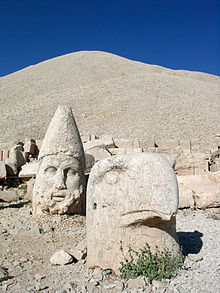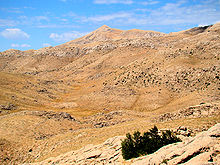- Mount Nemrut
-
- Turkey also has a volcano named Nemrut
Mount Nemrut * UNESCO World Heritage SiteCountry Turkey Type Cultural Criteria i, iii, iv Reference 448 Region ** Europe and Asia Inscription history Inscription 1987 (11th Session) * Name as inscribed on World Heritage List
** Region as classified by UNESCONemrut or Nemrud (Turkish: Nemrut Dağı ; Armenian: Նեմրութ լեռ) is a 2,134 m (7,001 ft) high mountain in southeastern Turkey, notable for the summit where a number of large statues is erected around what is assumed to be a royal tomb from the 1st century BCE.
Contents
Location and description
The mountain lies 40 km (25 mi) north of Kahta, near Adıyaman. In 62 BC, King Antiochus I Theos of Commagene built on the mountain top a tomb-sanctuary flanked by huge statues (8–9 m/26–30 ft high) of himself, two lions, two eagles and various Greek, Armenian, and Iranian gods, such as Hercules-Vahagn, Zeus-Aramazd or Oromasdes (associated with the Iranic god Ahura Mazda), Tyche, and Apollo-Mithras. These statues were once seated, with names of each god inscribed on them. The heads of the statues have at some stage been removed from their bodies, and they are now scattered throughout the site.
The pattern of damage to the heads (notably to noses) suggests that they were deliberately damaged because of belief in iconoclasm. The statues have not been restored to their original positions. The site also preserves stone slabs with bas-relief figures that are thought to have formed a large frieze. These slabs display the ancestors of Antiochus, who included both Greek and Persians.
The same statues and ancestors found throughout the site can also be found on the tumulus at the site, which is 49 m (161 ft) tall and 152 m (499 ft) in diameter. The statues appear to have Greek-style facial features, but Persian clothing and hairstyling.
The western terrace contains a large slab with a lion, showing the arrangement of stars and the planets Jupiter, Mercury and Mars on 7 July 62 BC. This may be an indication of when construction began on this monument. The eastern portion is well preserved, being composed of several layers of rock, and a path following the base of the mountain is evidence of a walled passageway linking the eastern and western terraces. Possible uses for this site is thought to have included religious ceremonies, due to the astronomical and religious nature of the monument.
The arrangement of such statues is known by the term hierothesion. Similar arrangements have been found at Arsameia on Nymphaios at the hierothesion of the father of Antiochus, Mithridates I Callinicus.
Ancient History
When the Seleucid Empire was defeated by the Romans in 189 BCE at the Battle of Magnesia it began to fall apart and new kingdoms were established on its territory by local authorities. Commagene being one of the Seleucid successor states occupied a land in between the Taurus mountains and the Euphrates. The state of Commagene had a wide range of cultures which left its leader from 62 BCE - 38 BCE Antiochus I to carry on a peculiar dynastic religious program, in which it included not only Greek and Persian deities but Antiochus and his family as well. This religious program was very possibly an attempt of Antiochus to unify his multiethnic kingdom and secure his dynasty's authority.[1]
Antiochus supported the cult as a propagator of happiness and salvation.[2] Many of the monuments on Mount Nemrud are ruins of the imperial cult of Commagene. The most important area to the cult was the tomb of Antiochus I, in which was decorated with colossal statues made of limestone. Although the Imperial cult did not last long after Antiochus, several of his successors had their own tombs built on Mount Nemrud.[3] For around half of the year, Mount Nemrud lays covered in snow which in effect has increased its weathering which has in part caused the statues to fall in ruin.[1]
Modern history
The site was excavated in 1881 by Charles Sester, a German engineer assessing transport routes for the Ottomans. Subsequent excavations have failed to reveal the tomb of Antiochus. This is nevertheless still believed to be the site of his burial. The statues, all of them "beheaded", have not been restored to their original condition.
Visiting Nemrut
In 1987, Mount Nemrut was made a World heritage site by UNESCO. Tourists typically visit Nemrut during June through August. The nearby town of Adıyaman is a popular place for car and bus trips to the site, and one can also travel from there by helicopter. There are also overnight tours running out of Malatya.
See also
- Queen of the Mountain--a documentary about the excavation of Nemrud dagh
- List of megalithic sites
- Cities of the ancient Near East
- Gods
References
- ^ a b Siliotti 2006, p. 217
- ^ Siliotti 2006, p. 218
- ^ Siliotti 2006, p. 220
Sources
- Siliotti, Alberto (2006), Hidden Treasures of Antiquity, Vercelli: VMB, ISBN 8854004979
External links
 UNESCO World Heritage Sites in Turkey
UNESCO World Heritage Sites in TurkeyAegean Hierapolis / Pamukkale · Xanthos / Letoon1
Black Sea Hittite Capital of Hattusa · Safranbolu
Central Anatolia Göreme and Rock Sites of Cappadocia · Great Mosque and Hospital of Divriği
Marmara Archaeological Site of Troy · Historic Areas of Istanbul · Selimiye Mosque and its Social Complex
Mediterranean Xanthos / Letoon1
Southeastern Anatolia Mount Nemrut in Commagene
1 Shared with other region/sNational parks of Turkey Aegean Region Black Sea Region Alacahöyük · Altındere · Hatila Valley · Kaçkar Mountains · Karagöl-Sahara · Küre Mountains · Mount Ilgaz · YedigöllerCentral Anatolia Region Eastern Anatolia Region Marmara Region Mediterranean Region Altınbeşik Cave · Beydağları Coast (Olympos) · Güllük Mountain (Termessos) · Karatepe-Aslantaş · Kızıldağ · Köprülü Canyon · Lake Kovada · Saklıkent CanyonSoutheastern Anatolia Region Mount Nemrut Mountains of Turkey
Mountains of TurkeyTwo main ranges Mountains Acıgöl • Akdağ • Aktaş • Ağrı (Ararat) • Babadağ • Beşparmak (Latmus) • Davraz • Dilek (Mycale) • Erciyes • Erek • Göllü • Hasan • Honaz • Kaçkar • Kadifekale • Karacadağ • Karadag • Karagöl • Kaz (Ida) • Kula • Küçük Ağrı • Madur • Mahya • Nemrut • Nemrut (volcano) • Nif • Palandöken • Spil • Sultan • Süphan • Şaphane • Tendürek • Topçambaba • Uludağ • Yamanlar • ZurbahanCoordinates: 37°58′54″N 38°44′28″E / 37.98167°N 38.74111°E
Categories:- World Heritage Sites in Turkey
- Commagene
- Mountains of Turkey
- National parks of Turkey
- 62 BC
- Adıyaman Province
- Visitor attractions in Adıyaman Province
- History of Adıyaman Province
Wikimedia Foundation. 2010.




